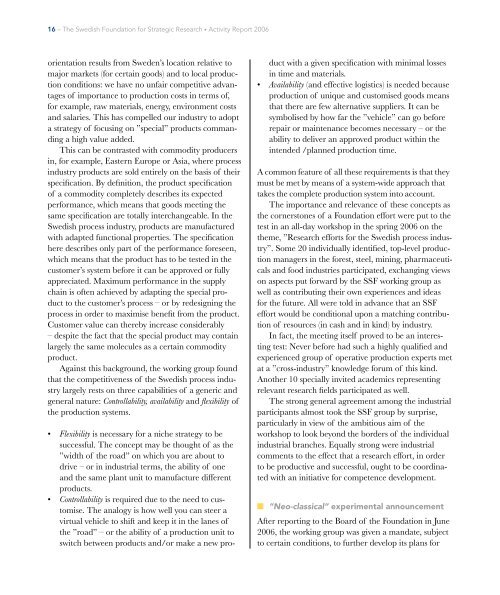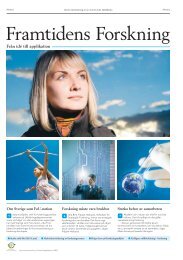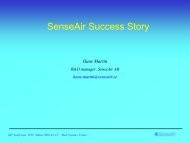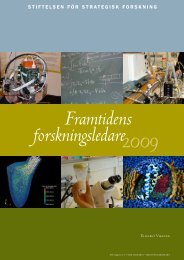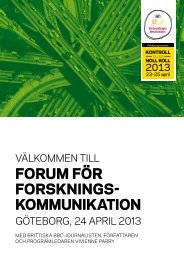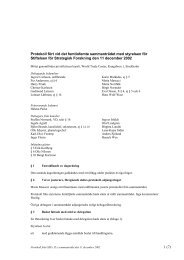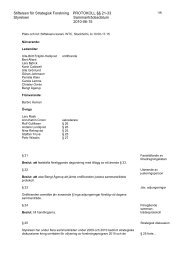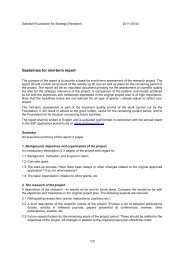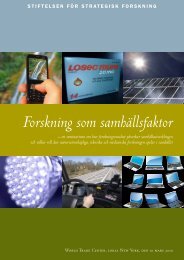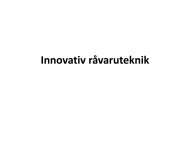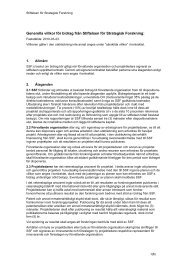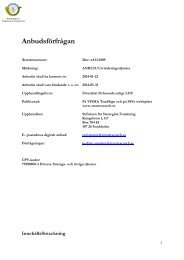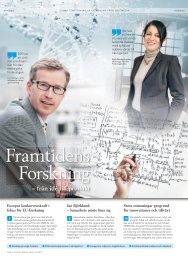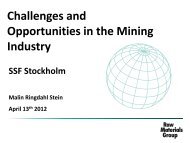Swedish Foundation for Strategic Research Activity Report 2006
Swedish Foundation for Strategic Research Activity Report 2006
Swedish Foundation for Strategic Research Activity Report 2006
You also want an ePaper? Increase the reach of your titles
YUMPU automatically turns print PDFs into web optimized ePapers that Google loves.
16 – The <strong>Swedish</strong> <strong>Foundation</strong> <strong>for</strong> <strong>Strategic</strong> <strong>Research</strong> • <strong>Activity</strong> <strong>Report</strong> <strong>2006</strong>orientation results from Sweden’s location relative tomajor markets (<strong>for</strong> certain goods) and to local productionconditions: we have no unfair competitive advantagesof importance to production costs in terms of,<strong>for</strong> example, raw materials, energy, environment costsand salaries. This has compelled our industry to adopta strategy of focusing on ”special” products commandinga high value added.This can be contrasted with commodity producersin, <strong>for</strong> example, Eastern Europe or Asia, where processindustry products are sold entirely on the basis of theirspecification. By definition, the product specificationof a commodity completely describes its expectedper<strong>for</strong>mance, which means that goods meeting thesame specification are totally interchangeable. In the<strong>Swedish</strong> process industry, products are manufacturedwith adapted functional properties. The specificationhere describes only part of the per<strong>for</strong>mance <strong>for</strong>eseen,which means that the product has to be tested in thecustomer’s system be<strong>for</strong>e it can be approved or fullyappreciated. Maximum per<strong>for</strong>mance in the supplychain is often achieved by adapting the special productto the customer’s process – or by redesigning theprocess in order to maximise benefit from the product.Customer value can thereby increase considerably– despite the fact that the special product may containlargely the same molecules as a certain commodityproduct.Against this background, the working group foundthat the competitiveness of the <strong>Swedish</strong> process industrylargely rests on three capabilities of a generic andgeneral nature: Controllability, availability and flexibility ofthe production systems.• Flexibility is necessary <strong>for</strong> a niche strategy to besuccessful. The concept may be thought of as the”width of the road” on which you are about todrive – or in industrial terms, the ability of oneand the same plant unit to manufacture differentproducts.• Controllability is required due to the need to customise.The analogy is how well you can steer avirtual vehicle to shift and keep it in the lanes ofthe ”road” – or the ability of a production unit toswitch between products and/or make a new productwith a given specification with minimal lossesin time and materials.• Availability (and effective logistics) is needed becauseproduction of unique and customised goods meansthat there are few alternative suppliers. It can besymbolised by how far the ”vehicle” can go be<strong>for</strong>erepair or maintenance becomes necessary – or theability to deliver an approved product within theintended /planned production time.A common feature of all these requirements is that theymust be met by means of a system-wide approach thattakes the complete production system into account.The importance and relevance of these concepts asthe cornerstones of a <strong>Foundation</strong> ef<strong>for</strong>t were put to thetest in an all-day workshop in the spring <strong>2006</strong> on thetheme, ”<strong>Research</strong> ef<strong>for</strong>ts <strong>for</strong> the <strong>Swedish</strong> process industry”.Some 20 individually identified, top-level productionmanagers in the <strong>for</strong>est, steel, mining, pharmaceuticalsand food industries participated, exchanging viewson aspects put <strong>for</strong>ward by the SSF working group aswell as contributing their own experiences and ideas<strong>for</strong> the future. All were told in advance that an SSFef<strong>for</strong>t would be conditional upon a matching contributionof resources (in cash and in kind) by industry.In fact, the meeting itself proved to be an interestingtest: Never be<strong>for</strong>e had such a highly qualified andexperienced group of operative production experts metat a ”cross-industry” knowledge <strong>for</strong>um of this kind.Another 10 specially invited academics representingrelevant research fields participated as well.The strong general agreement among the industrialparticipants almost took the SSF group by surprise,particularly in view of the ambitious aim of theworkshop to look beyond the borders of the individualindustrial branches. Equally strong were industrialcomments to the effect that a research ef<strong>for</strong>t, in orderto be productive and successful, ought to be coordinatedwith an initiative <strong>for</strong> competence development.n ”Neo-classical” experimental announcementAfter reporting to the Board of the <strong>Foundation</strong> in June<strong>2006</strong>, the working group was given a mandate, subjectto certain conditions, to further develop its plans <strong>for</strong>


